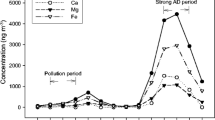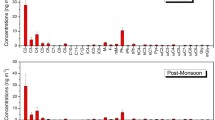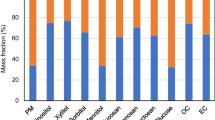Abstract
Introduction
Levoglucosan and carbonaceous species in the background aerosol of coastal southeast China were measured at Jianfengling (JFL), a background mountain site in a National Reserve Park on Hainan Island, and at Hok Tsui (HT), a rural site on the southern coast of Hong Kong from April to May of 2004 during an intensive field study.
Methods
We integrated the information from field study, satellite and backward trajectory model to examine the long-range transport of biomass burning smoke from the Philippines and assess its impact on background aerosol in coastal southeast China.
Results and discussion
The average levoglucosan concentrations were 42 and 30 ng m−3 at JFL and HT, respectively, while the organic and elemental carbon concentrations were 3.1 and 0.4 μg C m−3 respectively at JFL, and 4.1 and 1.3 μg C m−3 respectively at HT. Elevated levoglucosan concentrations of 85–106 ng m−3 (250–340% extra loadings) at JFL and 57 ng m−3 (170% extra loading) at HT were observed during transport events in which air masses originated from the Philippines. Fire hot spot counts and aerosol index derived from satellite data showed that the spread of biomass burning smoke from the Philippines resulted in large-scale dense aerosol clouds in the adjacent South China Sea and the western Pacific Ocean. The observed high ratio of two biomass-burning tracers (levoglucosan to mannosan) at JFL (7–36) and HT (27) indicated that the biomass smoke originating from the Philippines had significant contributions from open-field burning of agricultural residues, such as rice straw. The pollution plumes were transported to southeast China resulting in elevated concentrations of carbonaceous aerosol and levoglucosan in particular. Using a simplified receptor-based approach, biomass smoke aerosol was estimated to account for 16–28% of OC in the background atmosphere of Hainan and 4.9% of OC at the rural site of Hong Kong during these episode cases, indicating that biomass burning smoke generated in the Philippines could have a significant contribution to background ambient aerosol of southeast coastal China.






Similar content being viewed by others
References
Bey I, Jacob DJ, Logan JA, Yantosca RM (2001) Asian chemical outflow to the Pacific in spring: origins, pathways, and budgets. J Geophys Res 106(D19):23097–23113. doi:10.1029/2001jd000806
Birch ME, Cary RA (1996) Elemental carbon-based method for occupational monitoring of particulate diesel exhaust: methodology and exposure issues. Analyst 121(9):1183–1190
Chan CY, Chan LY, Chang WL, Zheng YG, Cui H, Zheng XD, Qin Y, Li YS (2003) Characteristics of a tropospheric ozone profile and implications for the origin of ozone over subtropical China in the spring of 2001. J Geophys Res 108(D20):8800. doi:10.1029/2003jd003427
Claeys M, Graham B, Vas G, Wang W, Vermeylen R, Pashynska V, Cafmeyer J, Guyon P, Andreae MO, Artaxo P, Maenhaut W (2004) Formation of secondary organic aerosols through photooxidation of isoprene. Science 303(5661):1173–1176. doi:10.1126/science.1092805
Duan J, Tan J, Cheng D, Bi X, Deng W, Sheng G, Fu J, Wong MH (2007) Sources and characteristics of carbonaceous aerosol in two largest cities in Pearl River Delta Region, China. Atmos Environ 41(14):2895–2903
Duncan BN, Martin RV, Staudt AC, Yevich R, Logan JA (2003) Interannual and seasonal variability of biomass burning emissions constrained by satellite observations. J Geophys Res 108(D2):4100. doi:10.1029/2002jd002378
Engling G, Carrico CM, Kreidenweis SM, Collett JL, Day DE, Malm WC, Lincoln E, Hao WM, Iinuma Y, Herrmann H (2006) Determination of levoglucosan in biomass combustion aerosol by high-performance anion-exchange chromatography with pulsed amperometric detection. Atmos Environ 40:S299–S311. doi:10.1016/j.atmosenv.2005.12.069
Engling G, Lee JJ, Tsai YW, Lung SCC, Chou CCK, Chan CY (2009) Size-resolved anhydrosugar composition in smoke aerosol from controlled field burning of rice straw. Aerosol Sci Technol 43(7):662–672. doi:10.1080/02786820902825113
Engling G, Zhang YN, Chan CY, Sang XF, Lin M, Ho KF, Li YS, Lin CY, Lee JJ (2011) Characterization and sources of aerosol particles over the southeastern Tibetan Plateau during the Southeast Asia biomass-burning season. Tellus Ser B Chem Phys Meteorol 63(1):117–128. doi:10.1111/j.1600-0889.2010.00512.x
FAO (2005) FAOSTAT agricultural database. Food and Agriculture Organization, Rome
Fraser MP, Lakshmanan K (2000) Using levoglucosan as a molecular marker for the long-range transport of biomass combustion aerosols. Environ Sci Technol 34(21):4560–4564. doi:10.1021/es991229l
Gadde B, Bonnet S, Menke C, Garivait S (2009) Air pollutant emissions from rice straw open field burning in India, Thailand and the Philippines. Environ Pollut 157(5):1554–1558
Hennigan CJ, Sullivan AP, Collett JL, Robinson AL (2010) Levoglucosan stability in biomass burning particles exposed to hydroxyl radicals. Geophys Res Lett 37. doi:L0980610.1029/2010gl043088
Hoffmann D, Tilgner A, Iinuma Y, Herrmann H (2010) Atmospheric stability of levoglucosan: a detailed laboratory and modeling study. Environ Sci Technol 44(2):694–699. doi:10.1021/es902476f
Iinuma Y, Engling G, Puxbaum H, Herrmann H (2009) A highly resolved anion-exchange chromatographic method for determination of saccharidic tracers for biomass combustion and primary bio-particles in atmospheric aerosol. Atmos Environ 43(6):1367–1371. doi:10.1016/j.atmosenv.2008.11.020
Jacob DJ, Crawford JH, Kleb MM, Connors VS, Bendura RJ, Raper JL, Sachse GW, Gille JC, Emmons L, Heald CL (2003) Transport and Chemical Evolution over the Pacific (TRACE-P) aircraft mission: design, execution, and first results. J Geophys Res 108(D20):9000. doi:10.1029/2002jd003276
Jimenez JL, Canagaratna MR et al (2009) Evolution of organic aerosols in the atmosphere. Science 326(5959):1525–1529. doi:10.1126/science.1180353
Mochida M, Kawamura K, Fu P, Takemura T (2010) Seasonal variation of levoglucosan in aerosols over the western North Pacific and its assessment as a biomass-burning tracer. Atmos Environ 44(29):3511–3518
Pope CA, Burnett RT, Thun MJ, Calle EE, Krewski D, Ito K, Thurston GD (2002) Lung cancer, cardiopulmonary mortality, and long-term exposure to fine particulate air pollution. J Am Med Assoc 287(9):1132–1141
Puxbaum H, Caseiro A, Sánchez-Ochoa A, Kasper-Giebl A, Claeys M, Gelencsér A, Legrand M, Preunkert S, Pio C (2007) Levoglucosan levels at background sites in Europe for assessing the impact of biomass combustion on the European aerosol background. J Geophys Res 112(D23):D23S05. doi:10.1029/2006jd008114
Qu WJ, Zhang XY, Arimoto R, Wang YQ, Wang D, Sheng LF, Fu G (2009) Aerosol background at two remote CAWNET sites in western China. Sci Total Environ 407(11):3518–3529. doi:10.1016/j.scitotenv.2009.02.012
Robinson AL, Donahue NM, Shrivastava MK, Weitkamp EA, Sage AM, Grieshop AP, Lane TE, Pierce JR, Pandis SN (2007) Rethinking organic aerosols: semivolatile emissions and photochemical aging. Science 315(5816):1259–1262. doi:10.1126/science.1133061
Sang XF, Chan CY, Engling G, Chan LY, Wang XM, Zhang YN, Shi S, Zhang ZS, Zhang T, Hu M (2011) Levoglucosan enhancement in ambient aerosol during springtime transport events of biomass burning smoke to Southeast China. Tellus Ser B Chem Phys Meteorol 63(1):129–139. doi:10.1111/j.1600-0889.2010.00515.x
Schmidl C, Marr LL, Caseiro A, Kotianova P, Berner A, Bauer H, Kasper-Giebl A, Puxbaum H (2008) Chemical characterisation of fine particle emissions from wood stove combustion of common woods growing in mid-European Alpine regions. Atmos Environ 42(1):126–141. doi:10.1016/j.atmosenv.2007.09.028
Simoneit BRT (1999) A review of biomarker compounds as source indicators and tracers for air pollution. Environ Sci Pollut Res Int 6(3):159–169
Streets DG, Yarber KF, Woo JH, Carmichael GR (2003) Biomass burning in Asia: annual and seasonal estimates and atmospheric emissions. Global Biogeochem Cy 17(4):1099. doi:10.1029/2003gb002040
Sullivan AP, Holden AS, Patterson LA, McMeeking GR, Kreidenweis SM, Malm WC, Hao WM, Wold CE, Collett JL (2008) A method for smoke marker measurements and its potential application for determining the contribution of biomass burning from wildfires and prescribed fires to ambient PM2.5 organic carbon. J Geophys Res 113. doi:D2230210.1029/2008jd010216
Turpin BJ, Huntzicker JJ (1995) Identification of secondary organic aerosol episodes and quantitation of primary and secondary organic aerosol concentrations during SCAQS. Atmos Environ 29(23):3527–3544
Wang T, Ding AJ, Blake DR, Zahorowski W, Poon CN, Li YS (2003) Chemical characterization of the boundary layer outflow of air pollution to Hong Kong during February to April 2001. J Geophys Res 108(D20):8787. doi:10.1029/2002jd003272
Wang W, Wu MH, Li L, Zhang T, Liu XD, Feng JL, Li HJ, Wang YJ, Sheng GY, Claeys M, Fu JM (2008) Polar organic tracers in PM2.5 aerosols from forests in eastern China. Atmos Chem Phys 8(24):7507–7518
Zhang YX, Shao M, Zhang YH, Zeng LM, He LY, Zhu B, Wei YJ, Zhu XL (2007) Source profiles of particulate organic matters emitted from cereal straw burnings. J Environ Sci 19(2):167–175
Zhang T, Claeys M, Cachier H, Dong SP, Wang W, Maenhaut W, Liu XD (2008) Identification and estimation of the biomass burning contribution to Beijing aerosol using levoglucosan as a molecular marker. Atmos Environ 42(29):7013–7021. doi:10.1016/j.atmosenv.2008.04.050
Zhang T, Engling G, Chan CY, Zhang YN, Zhang ZS, Lin M, Sang XF, Li YD, Li YS (2010a) Contribution of fungal spores to particulate matter in a tropical rainforest. Environ Res Lett 5(2):doi:02401010.1088/1748-9326/5/2/024010
Zhang X, Hecobian A, Zheng M, Frank NH, Weber RJ (2010b) Biomass burning impact on PM2.5 over the southeastern US during 2007: integrating chemically speciated FRM filter measurements, MODIS fire counts and PMF analysis. Atmos Chem Phys Discuss 10(14):6839–6853. doi:10.5194/acp-10-6839-2010
Zhang ZS, Engling G, Lin CY, Chou CCK, Lung SC, Chang SY, Fan S, Chan CY, Zhang YH (2010c) Chemical speciation, transport and contribution of biomass burning smoke to ambient aerosol in Guangzhou, a mega city of China. Atmos Environ 44(26):3187–3195
Acknowledgments
This work was funded by the China National Natural Science Fund (No. 40975078 and No. 40875075), the Guangdong Province Natural Science Fund (No. 8251027501000002), joint fund of China and Guangdong National Natural Science Fund (U0833001), the National High-Tech 863 Project of China under grant No. 2006AA06A308, as well as the Fundamental Research Funds for the Central Universities.
Author information
Authors and Affiliations
Corresponding author
Additional information
Responsible editor: Euripides Stephanou
Rights and permissions
About this article
Cite this article
Zhang, YN., Zhang, ZS., Chan, CY. et al. Levoglucosan and carbonaceous species in the background aerosol of coastal southeast China: case study on transport of biomass burning smoke from the Philippines. Environ Sci Pollut Res 19, 244–255 (2012). https://doi.org/10.1007/s11356-011-0548-7
Received:
Accepted:
Published:
Issue Date:
DOI: https://doi.org/10.1007/s11356-011-0548-7




